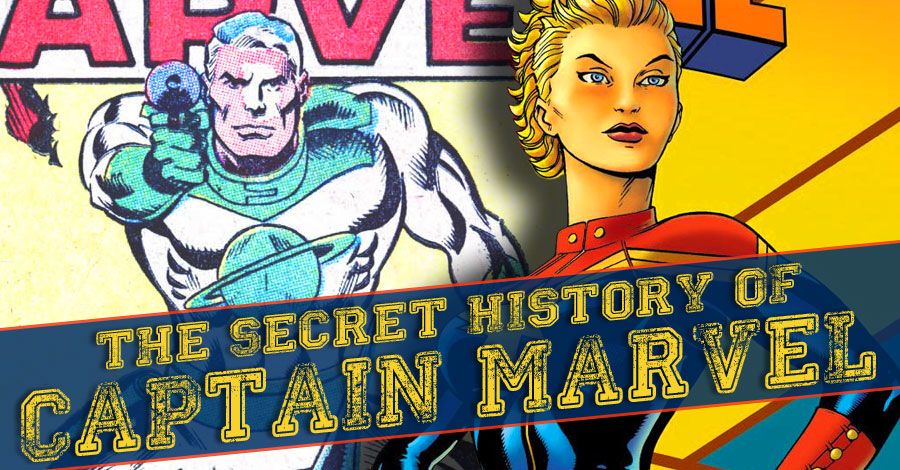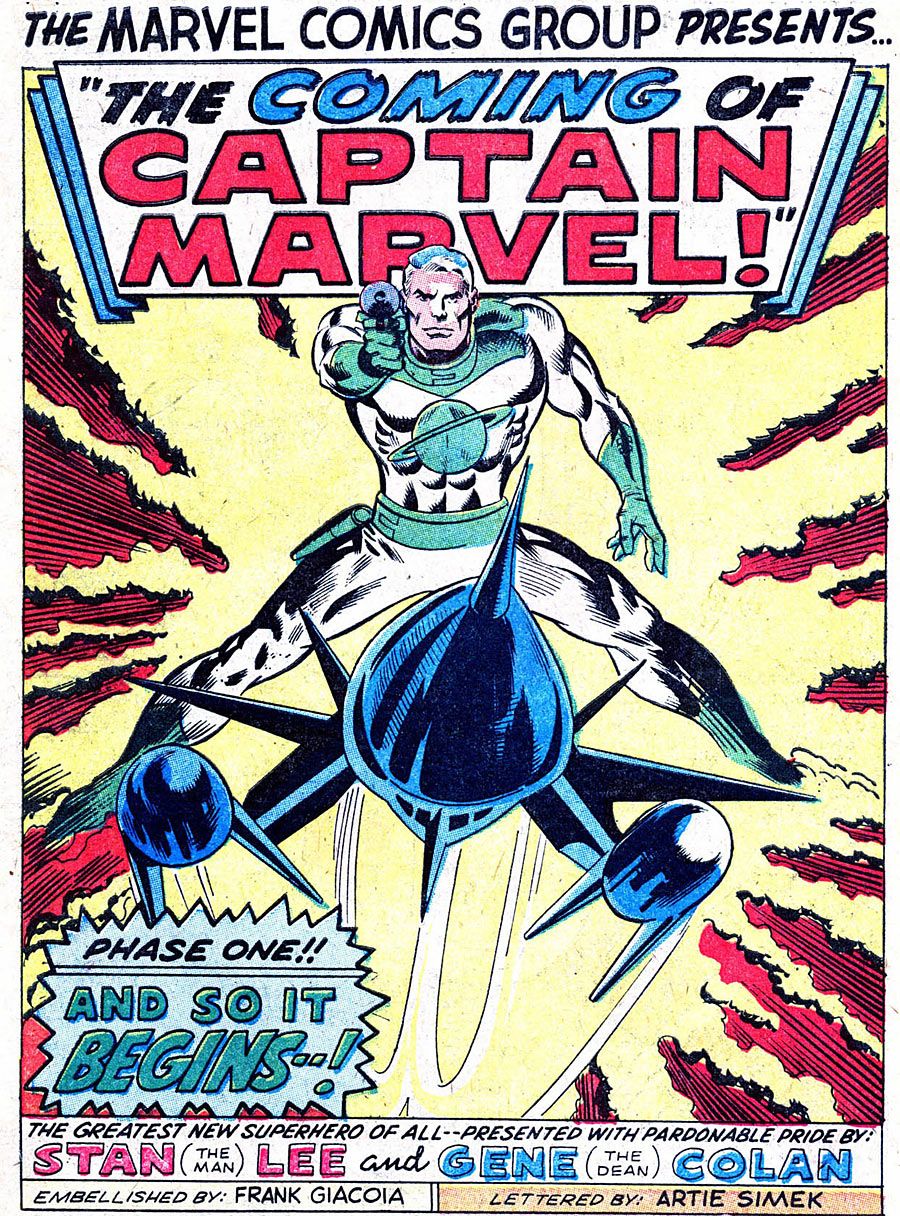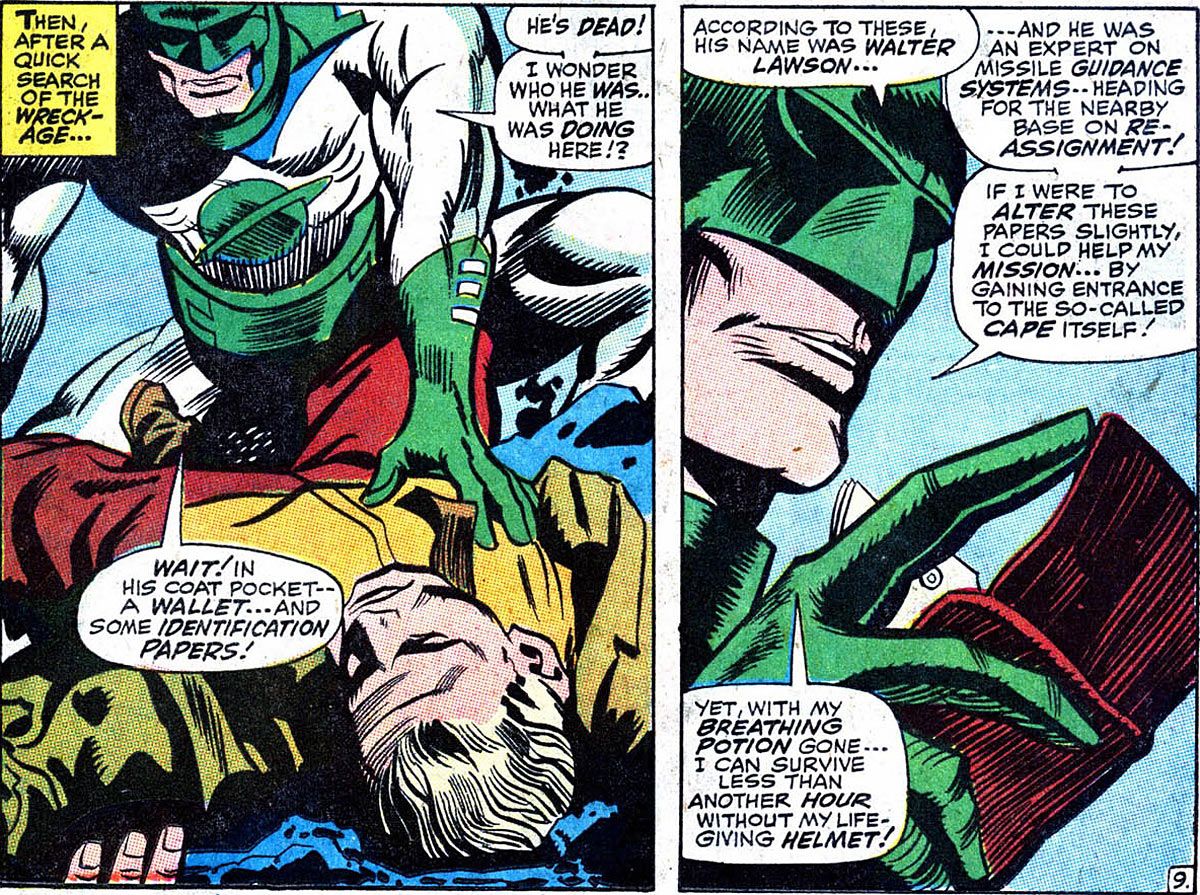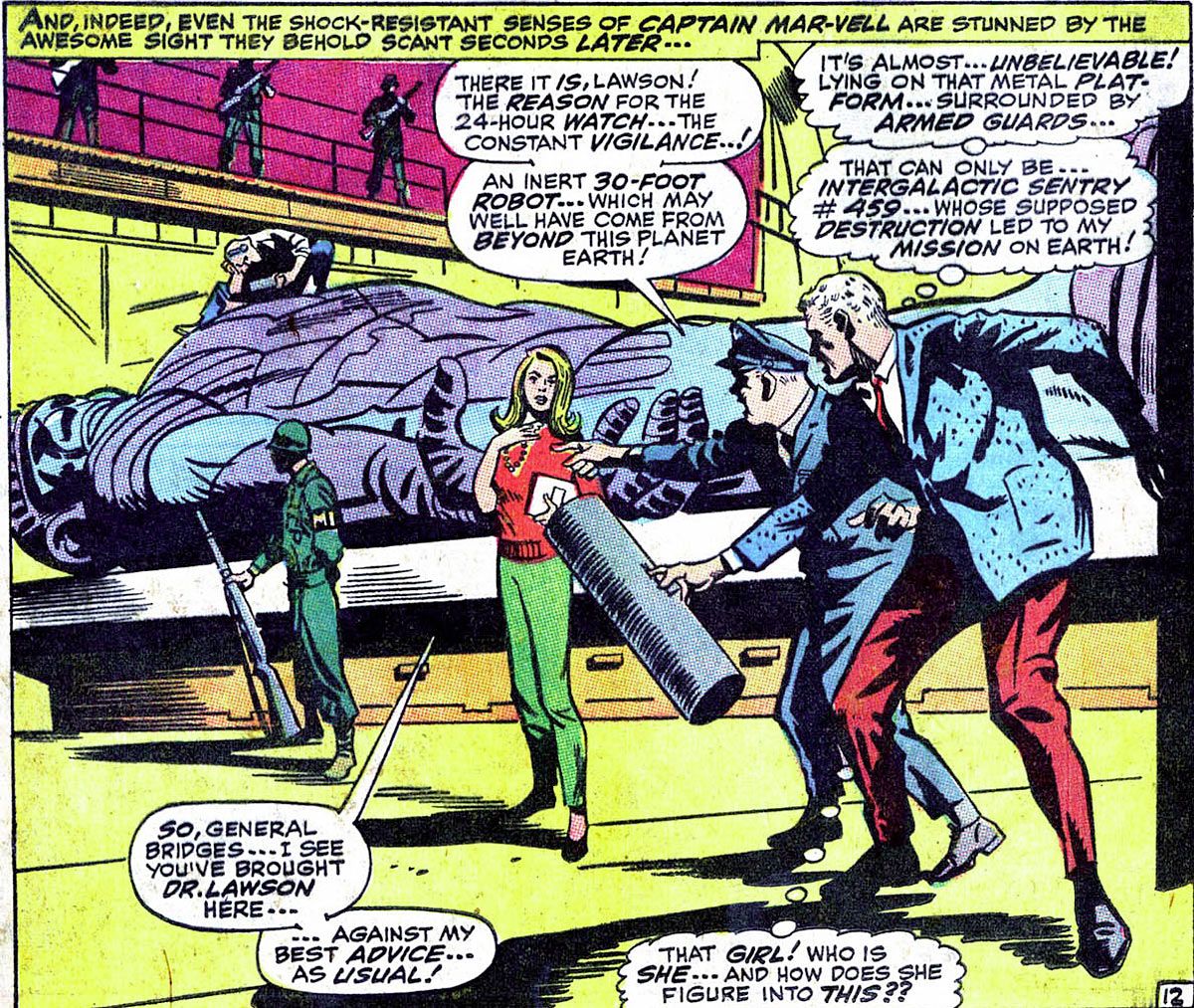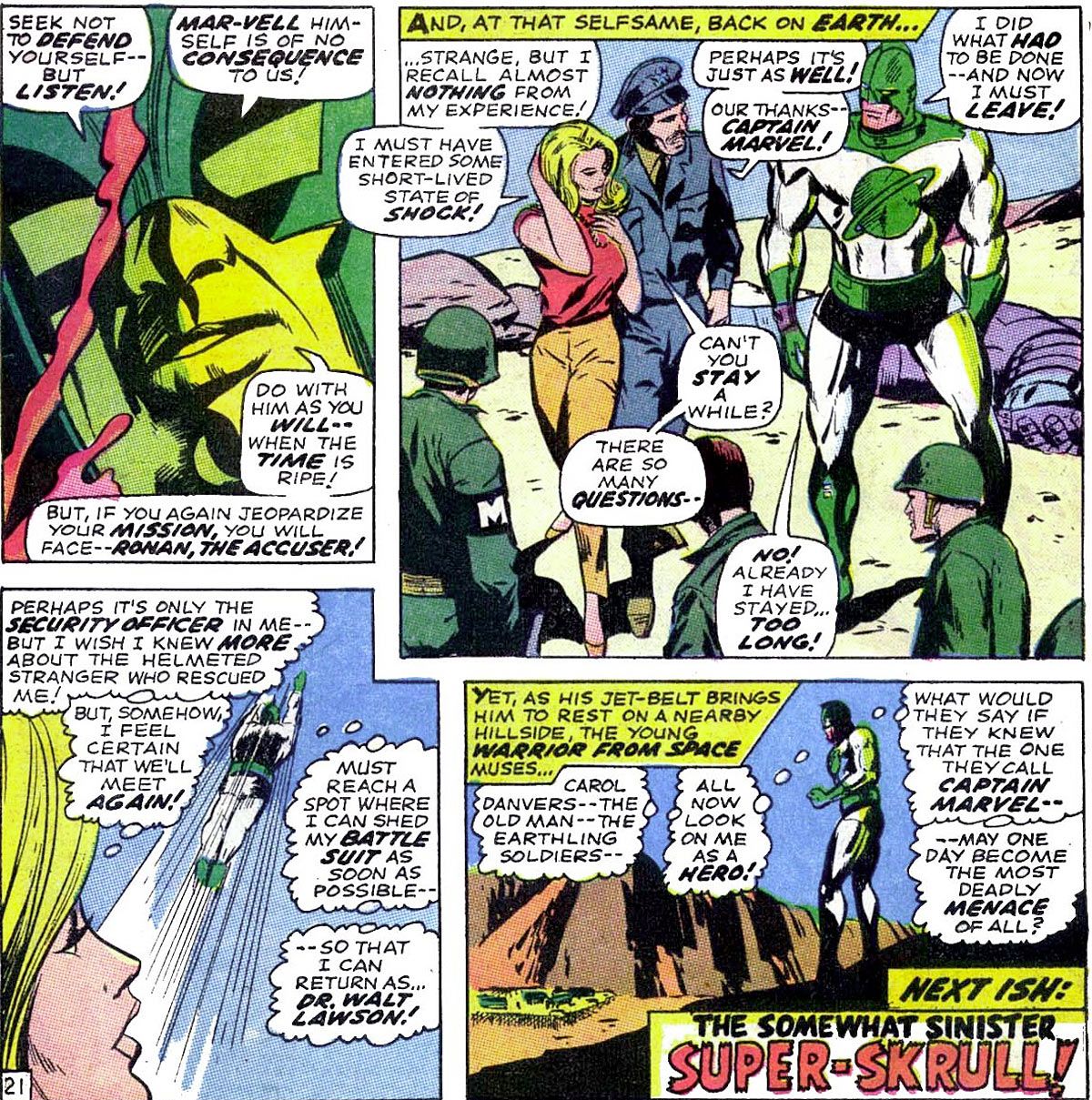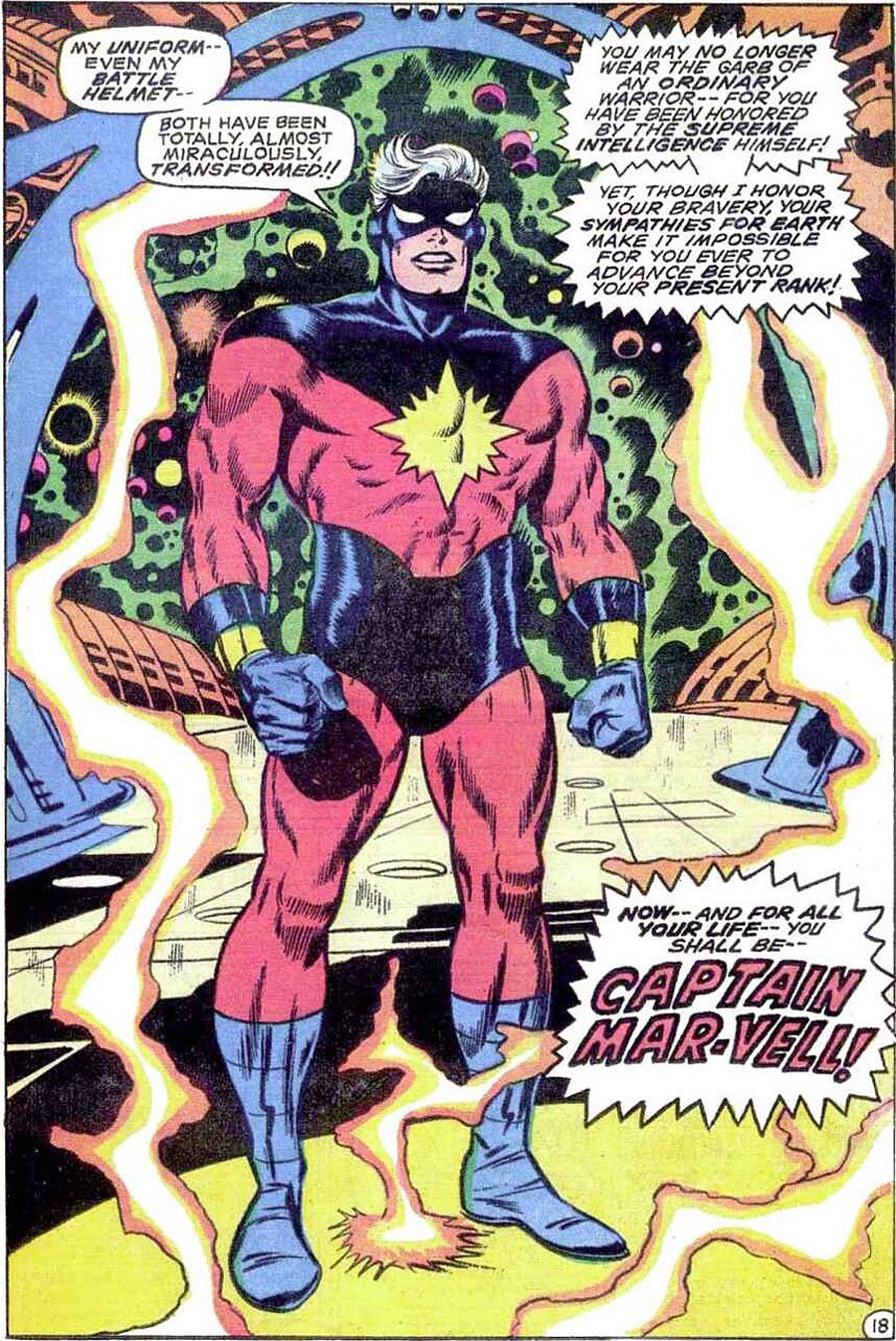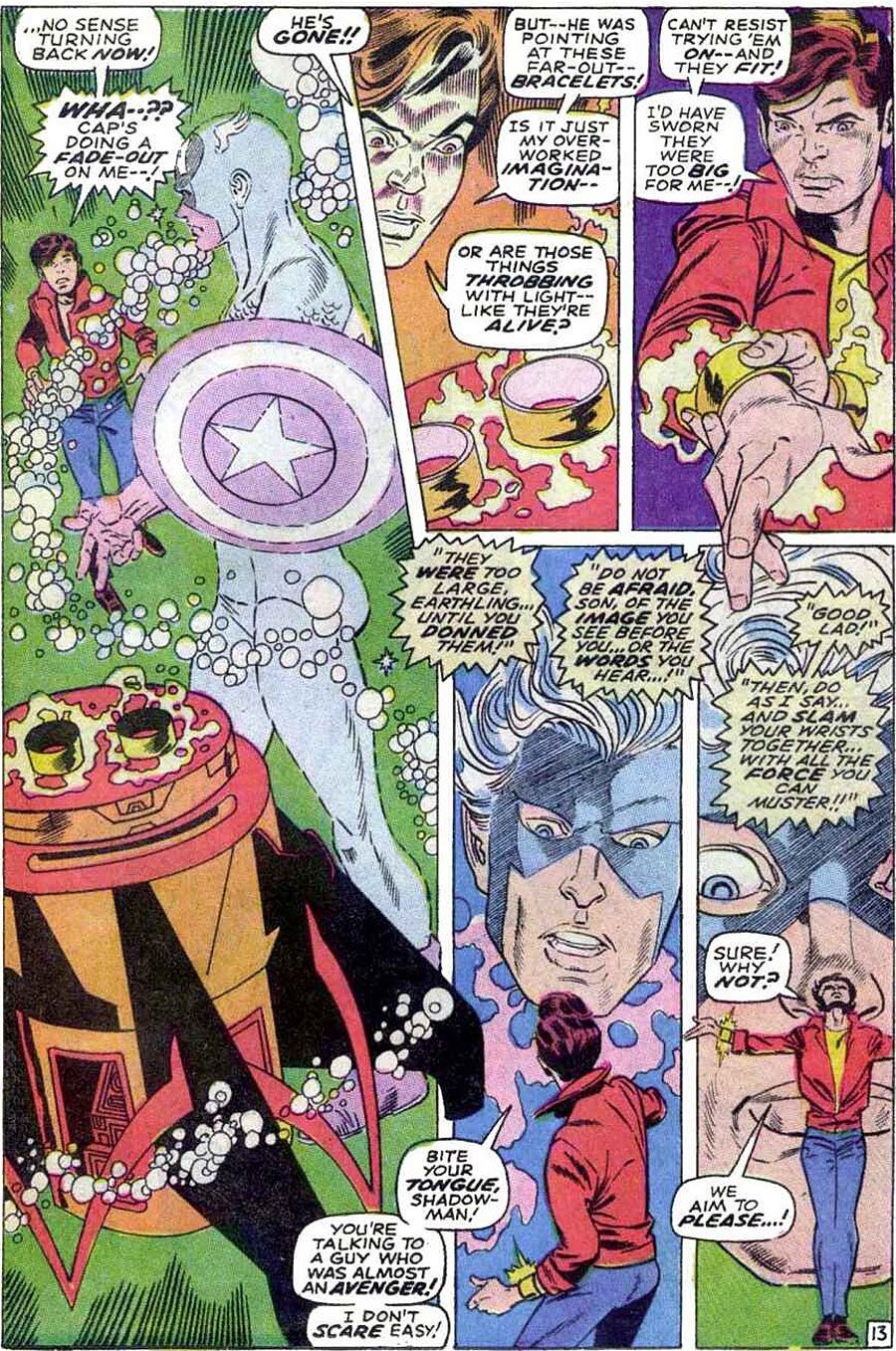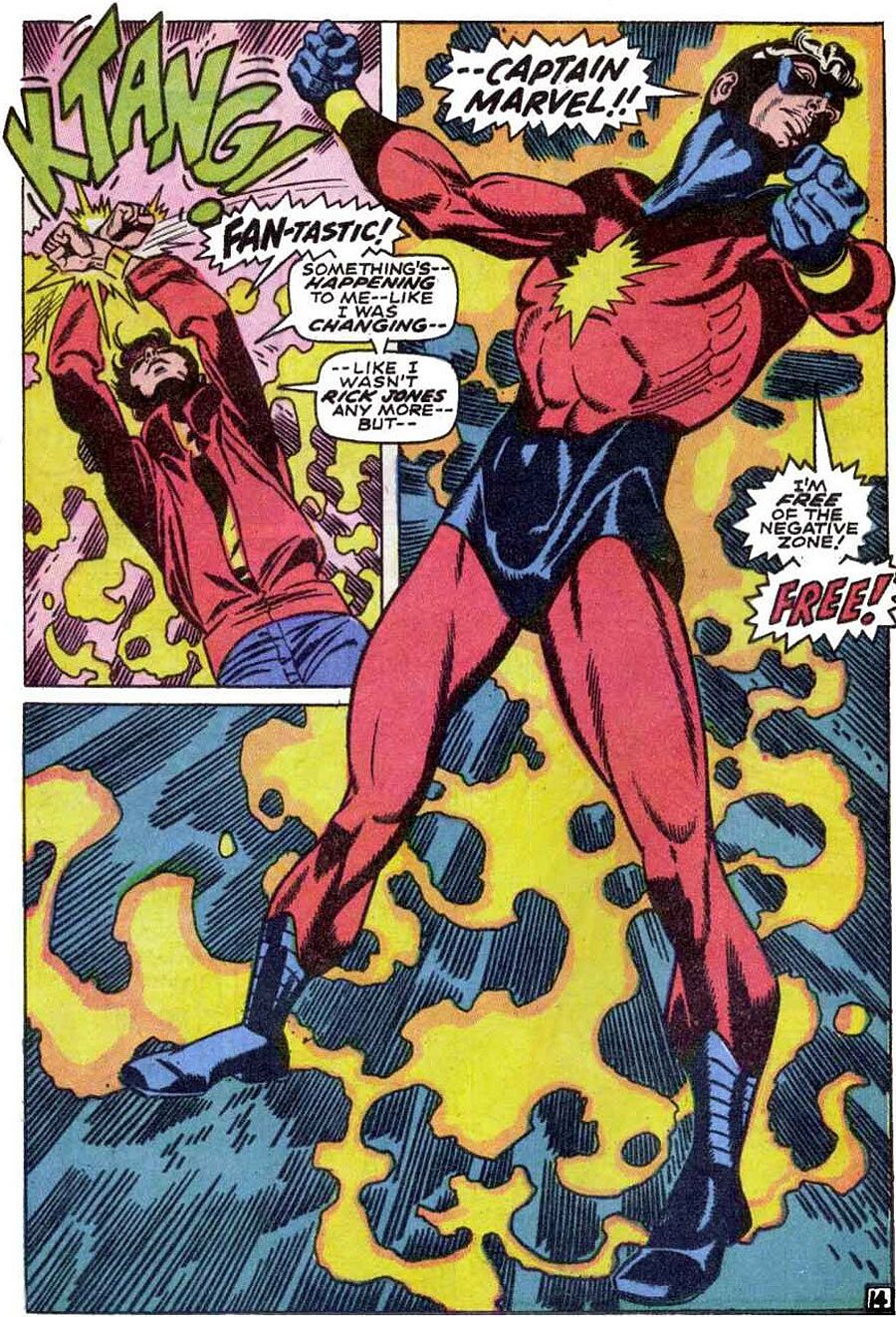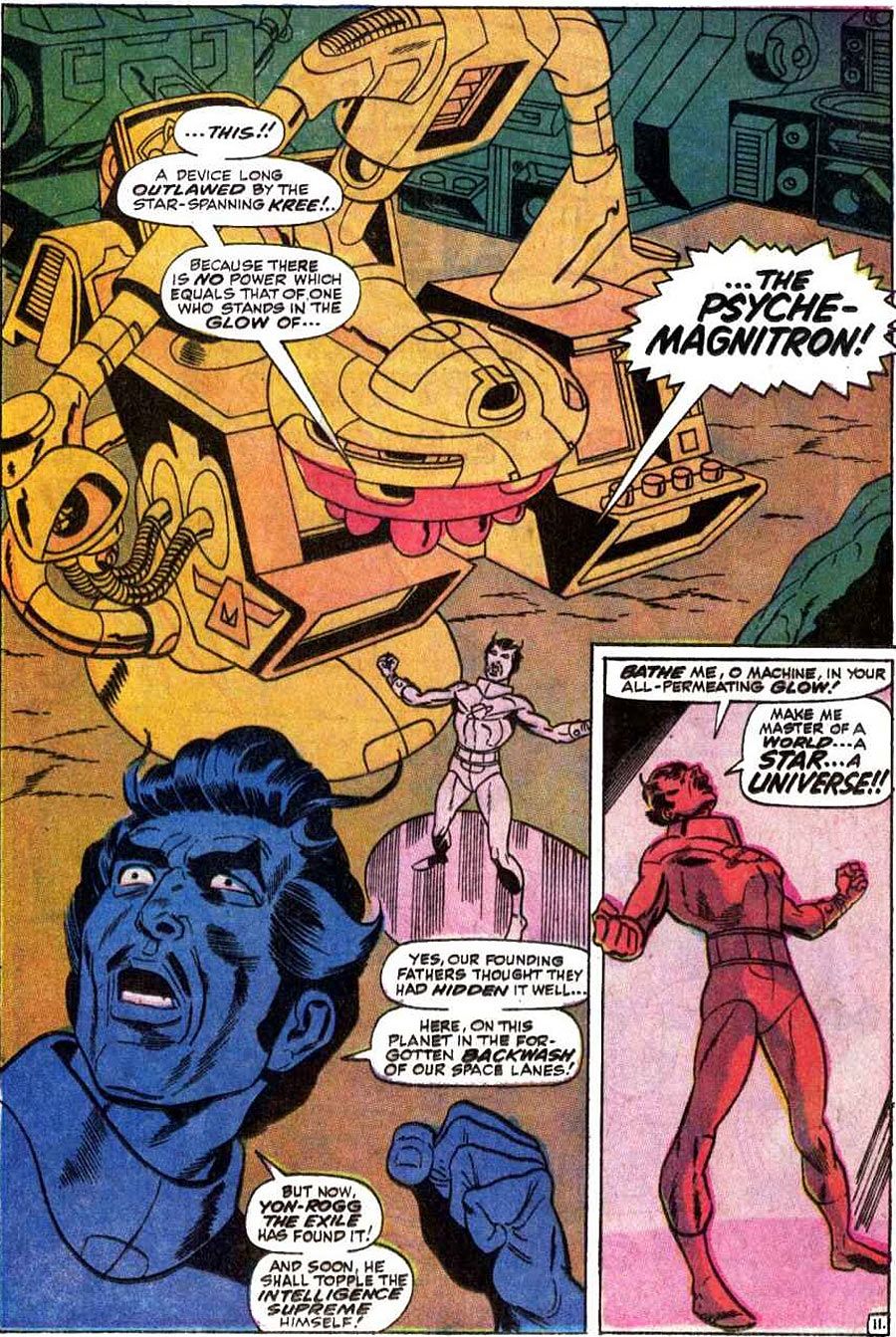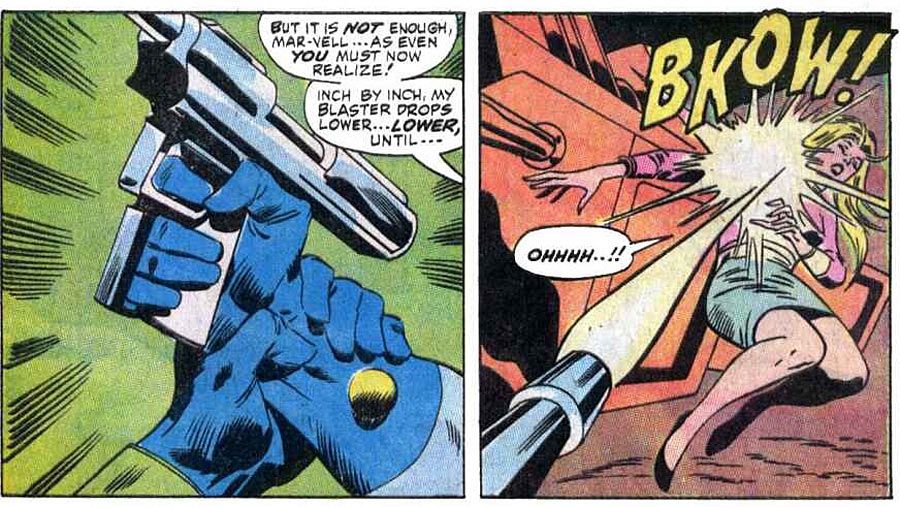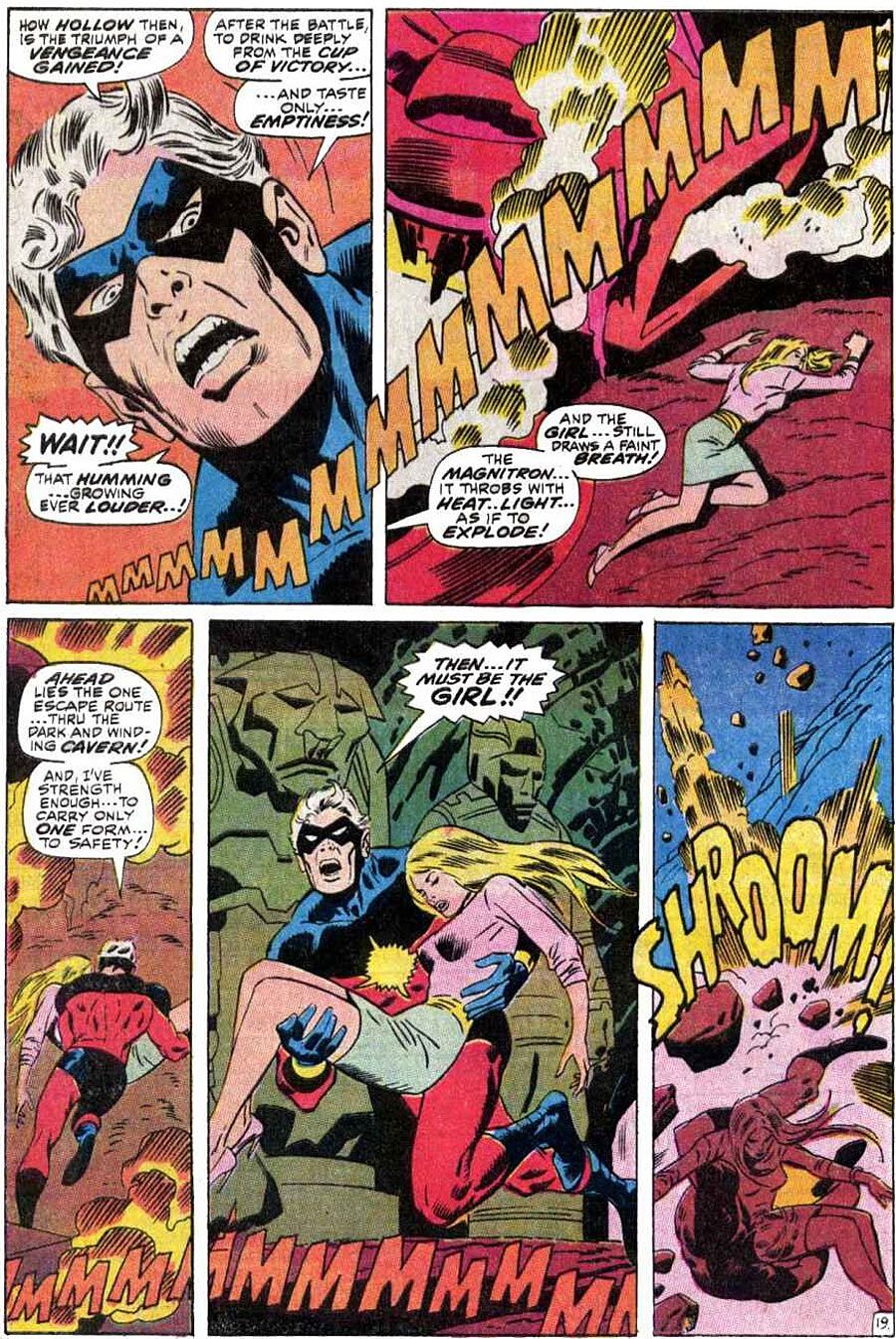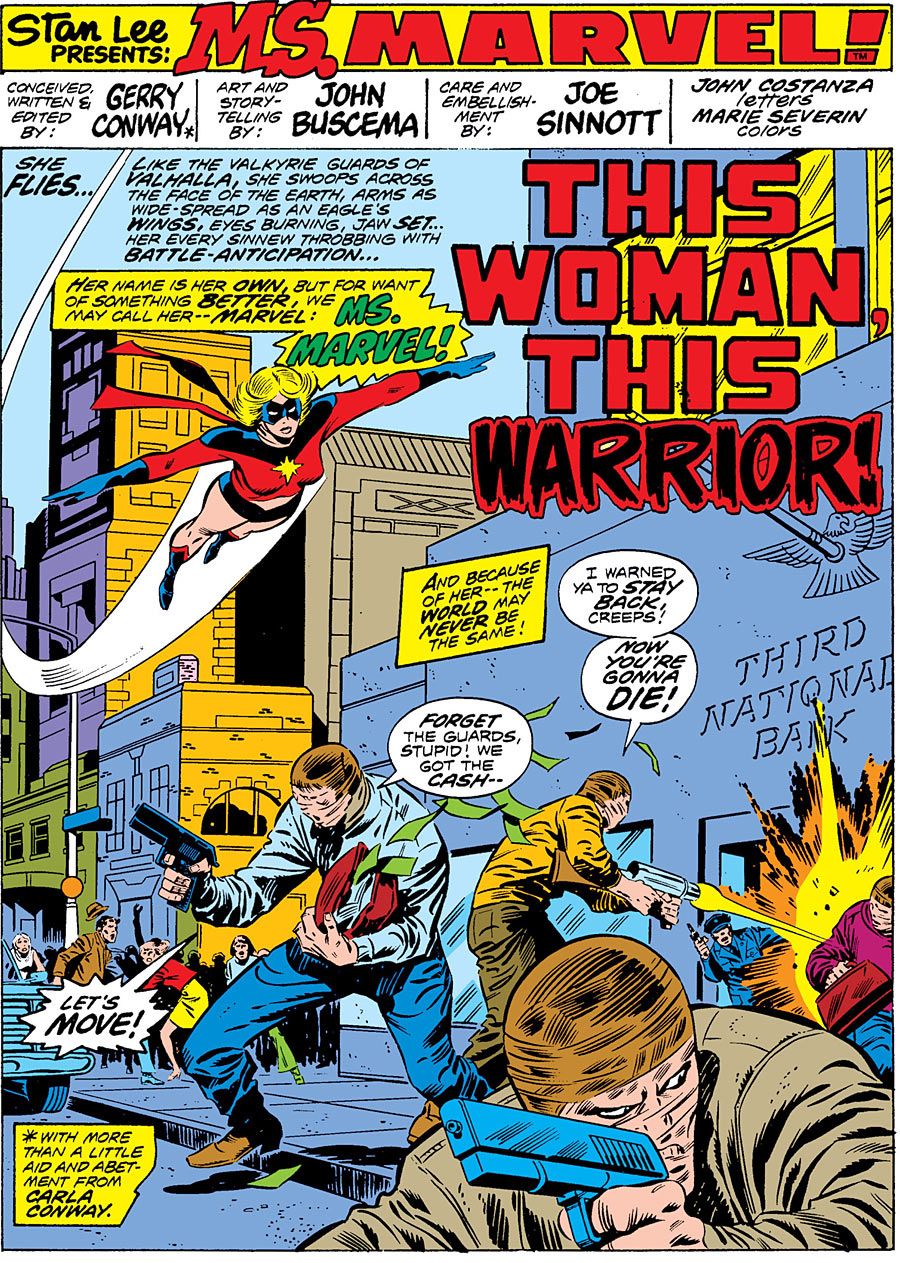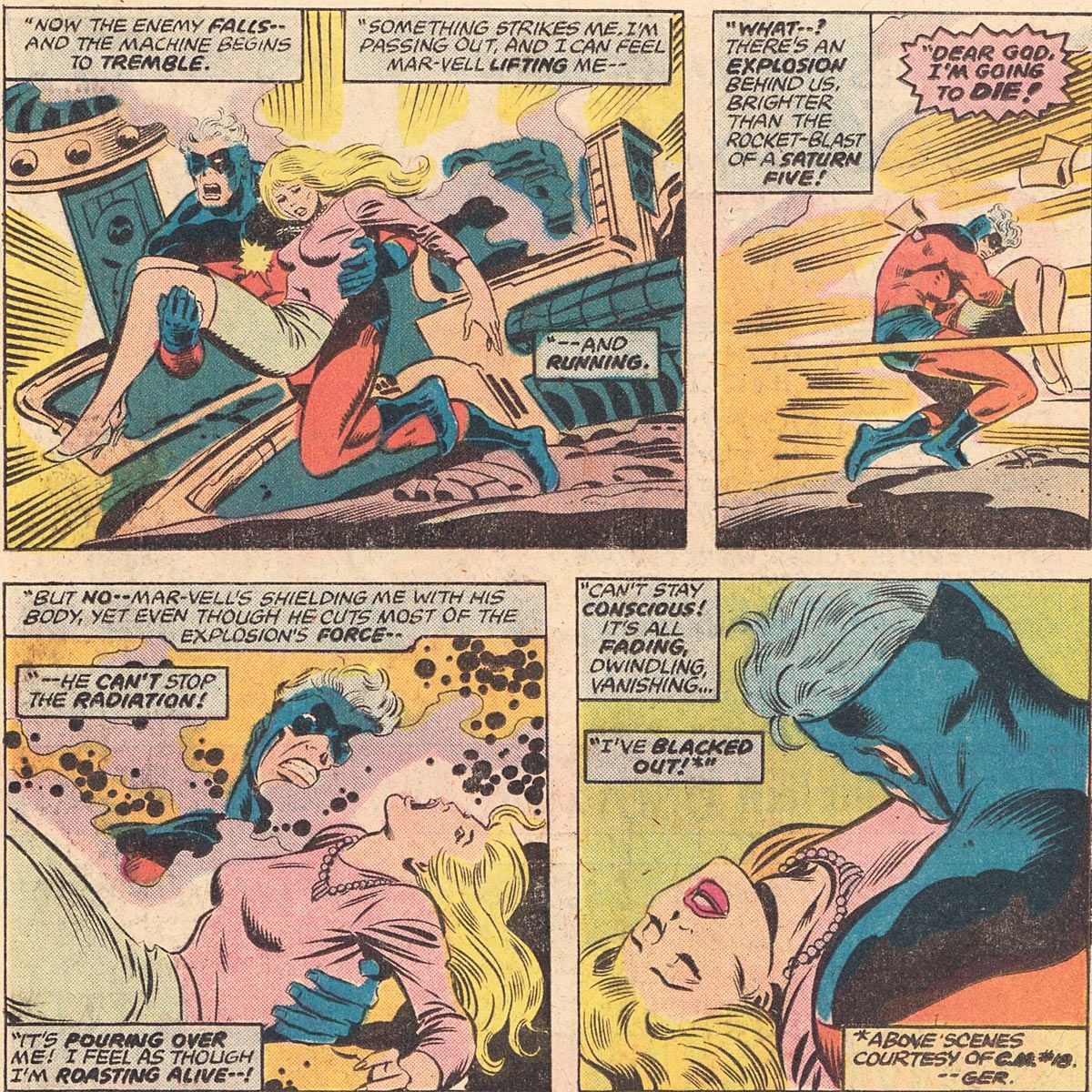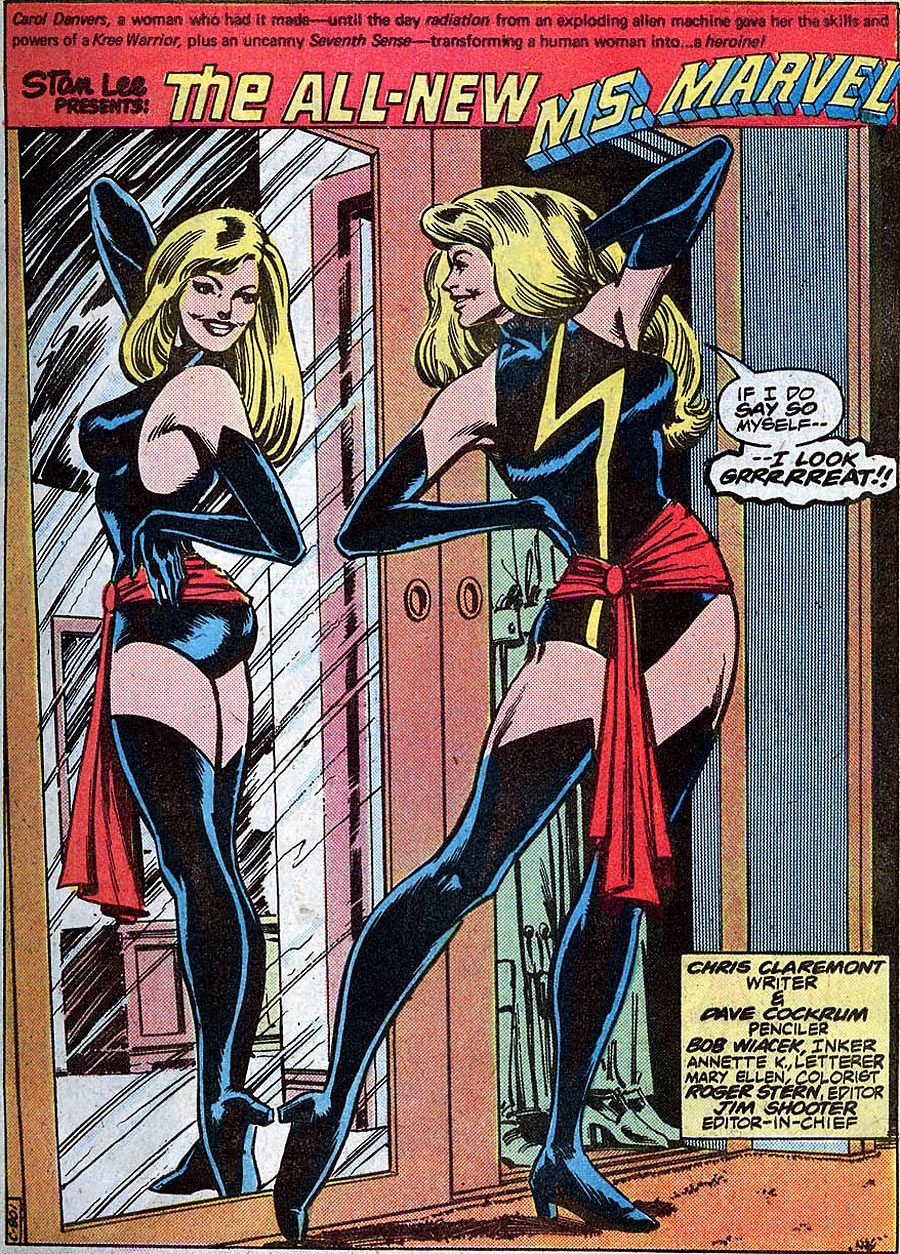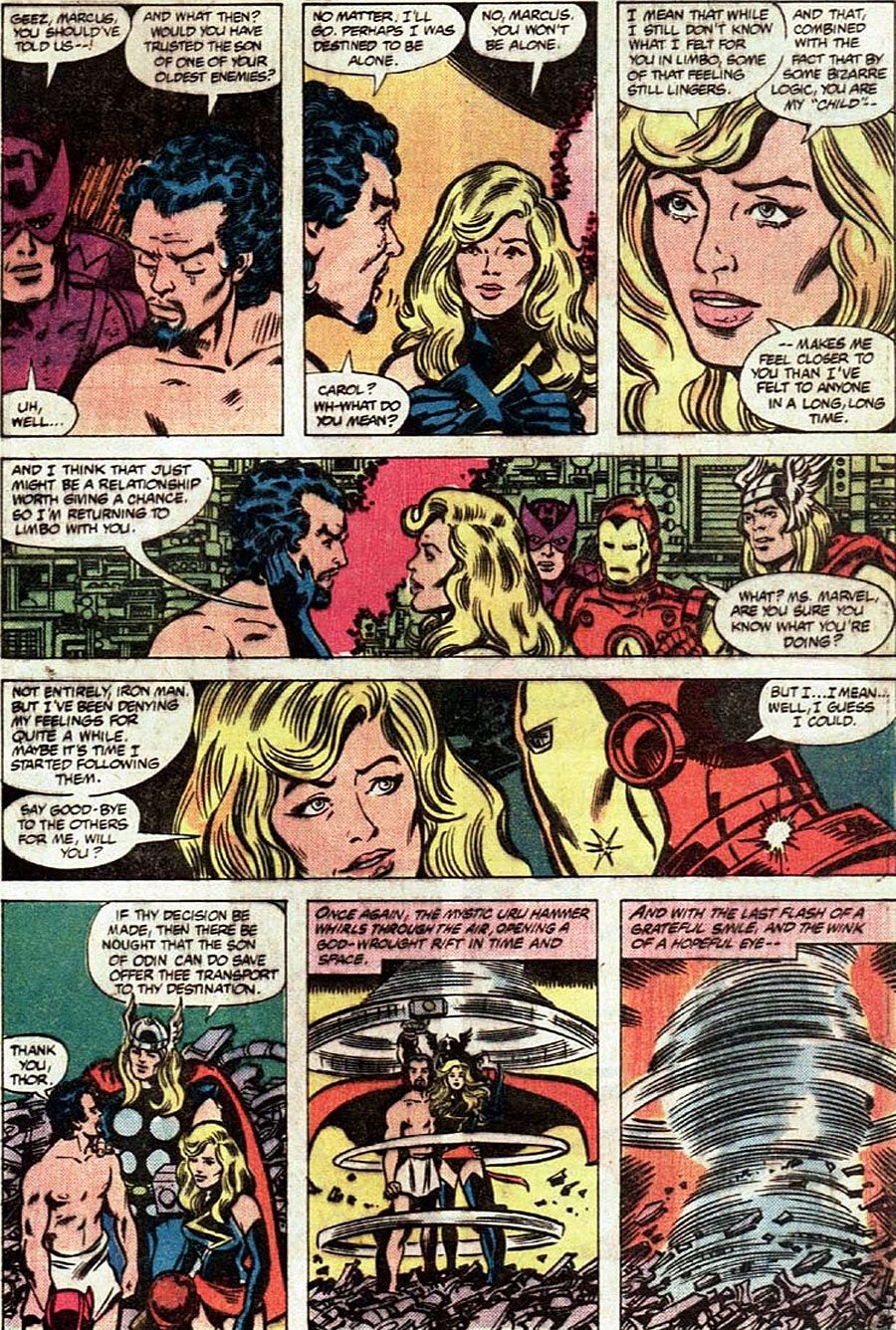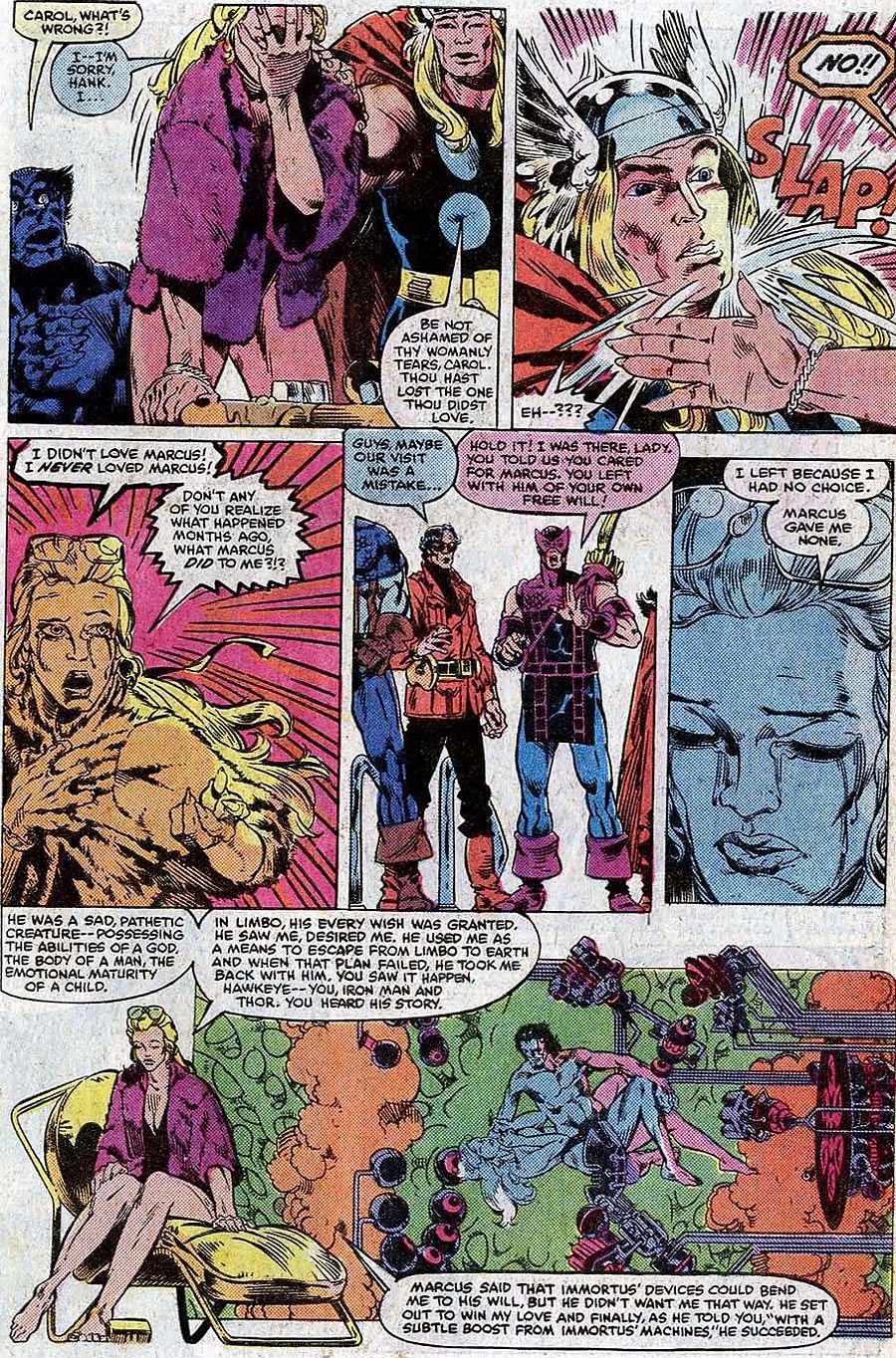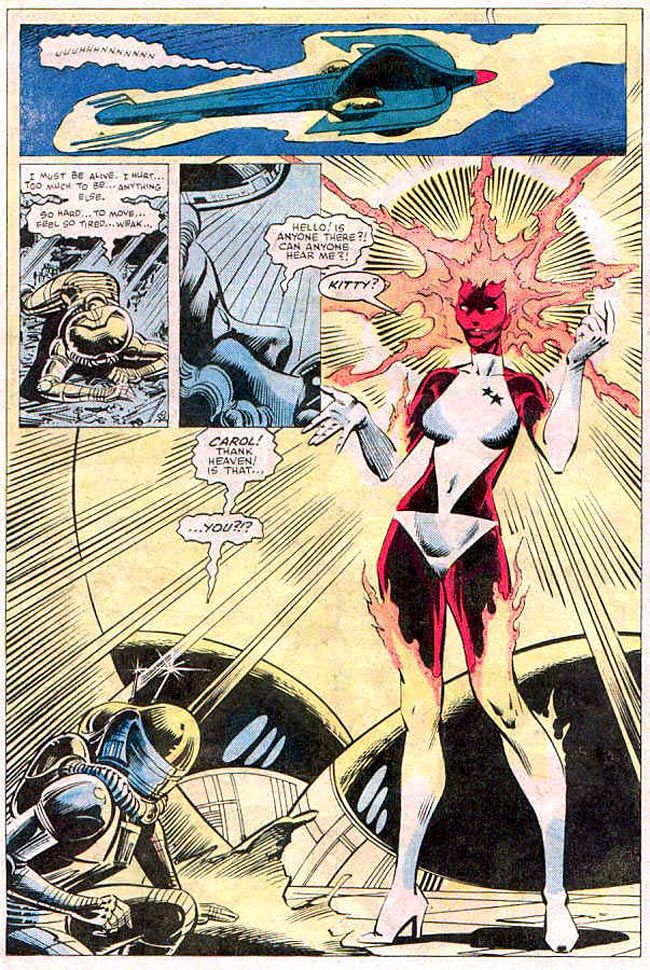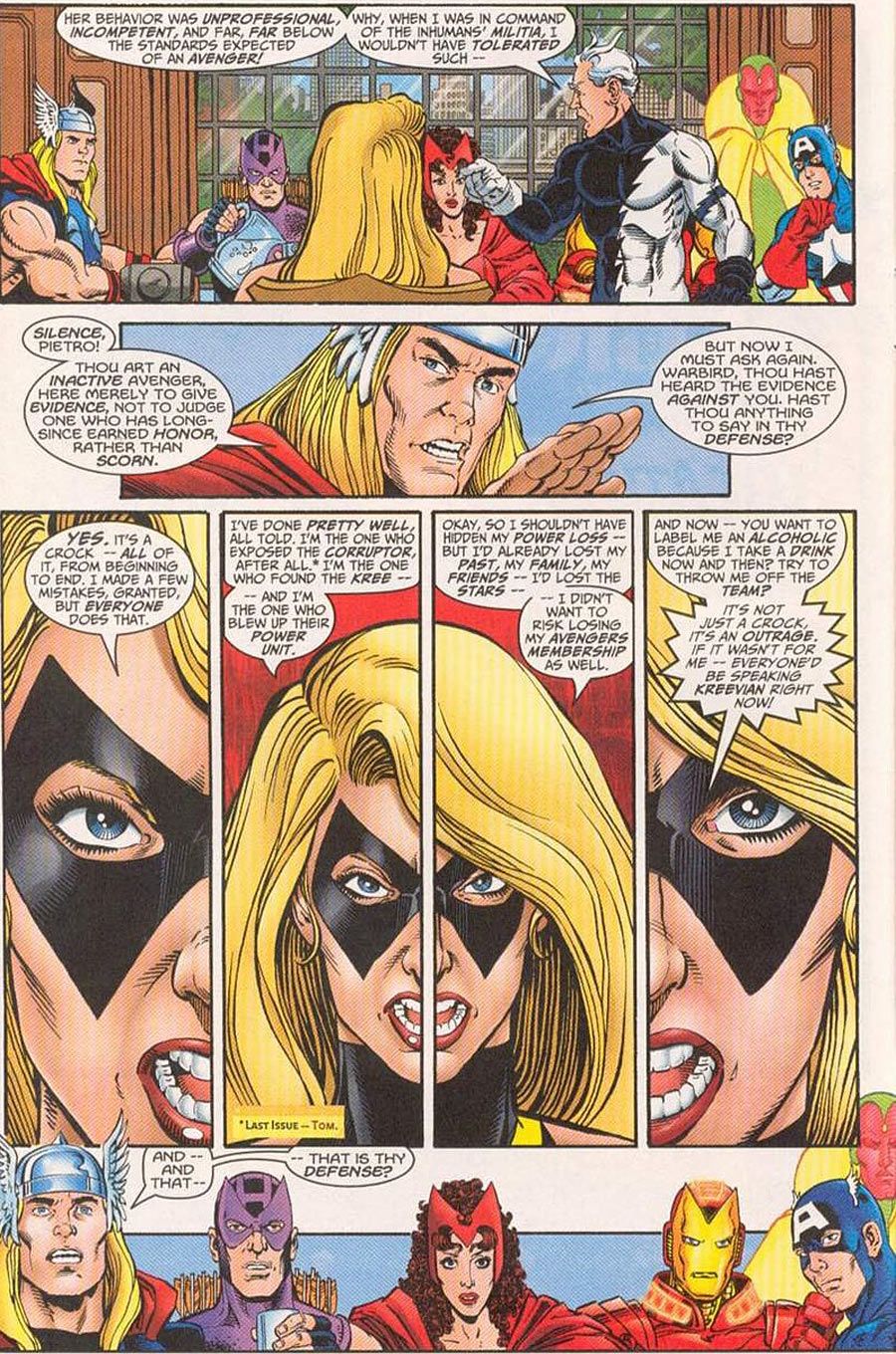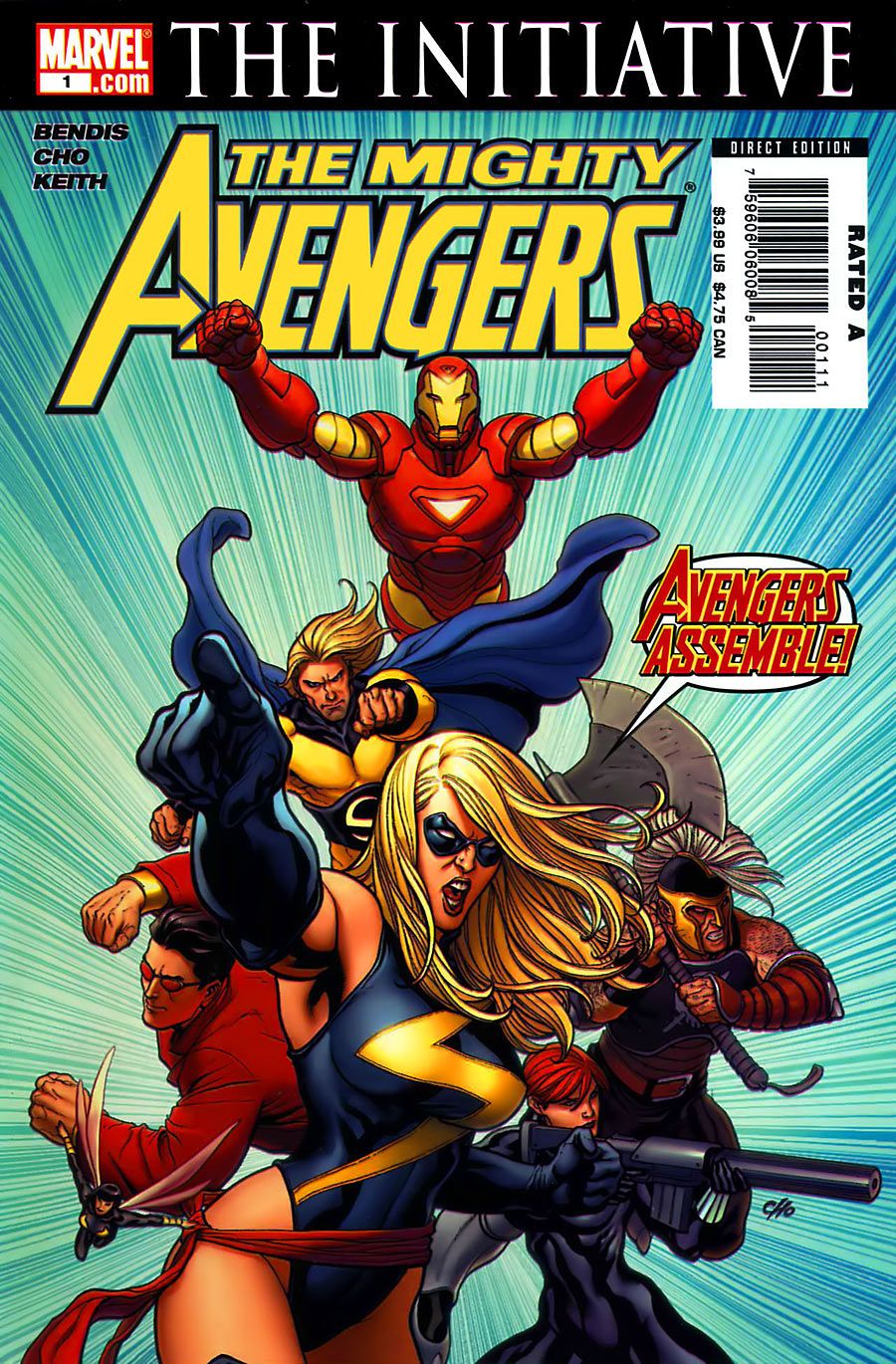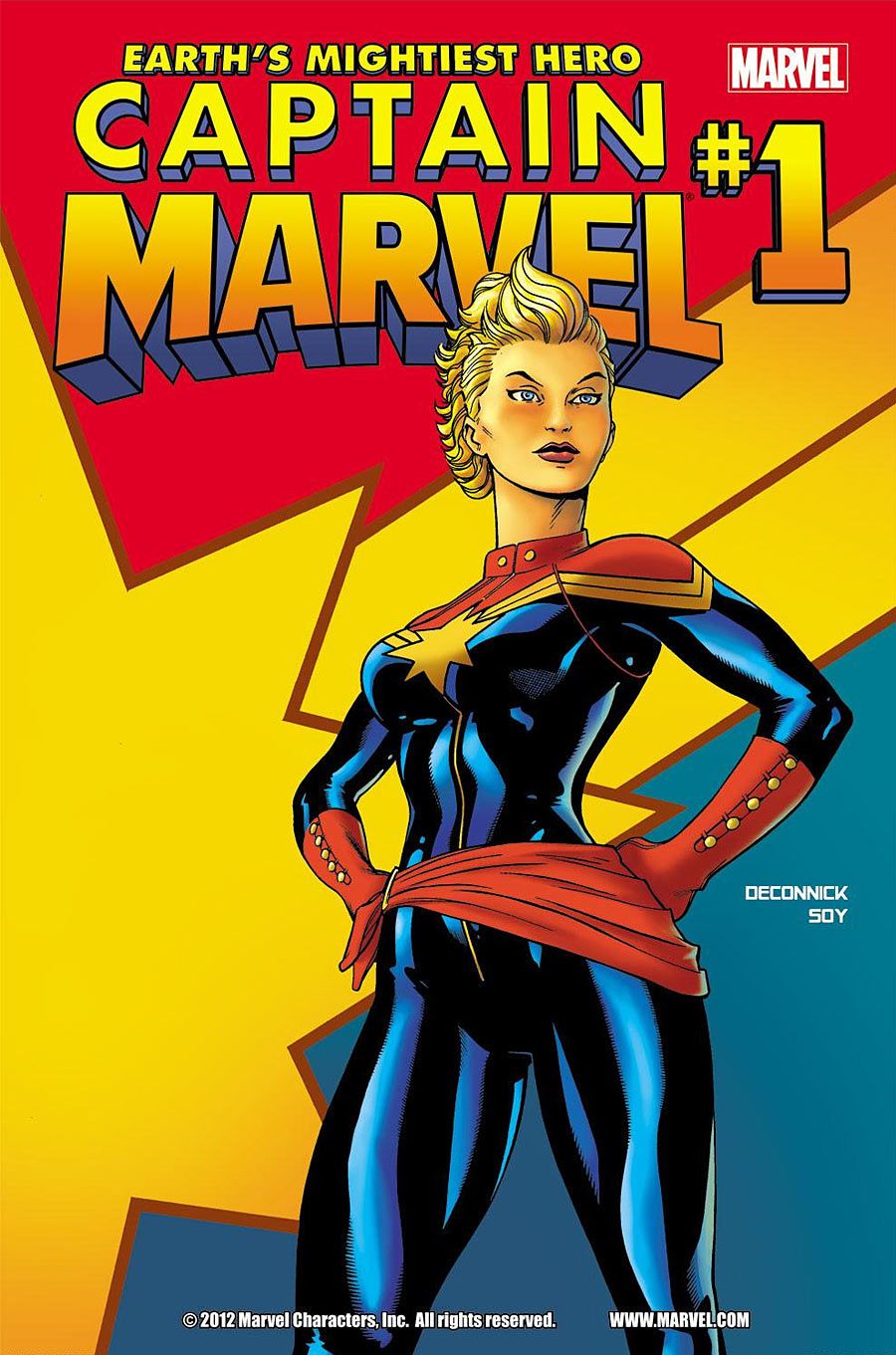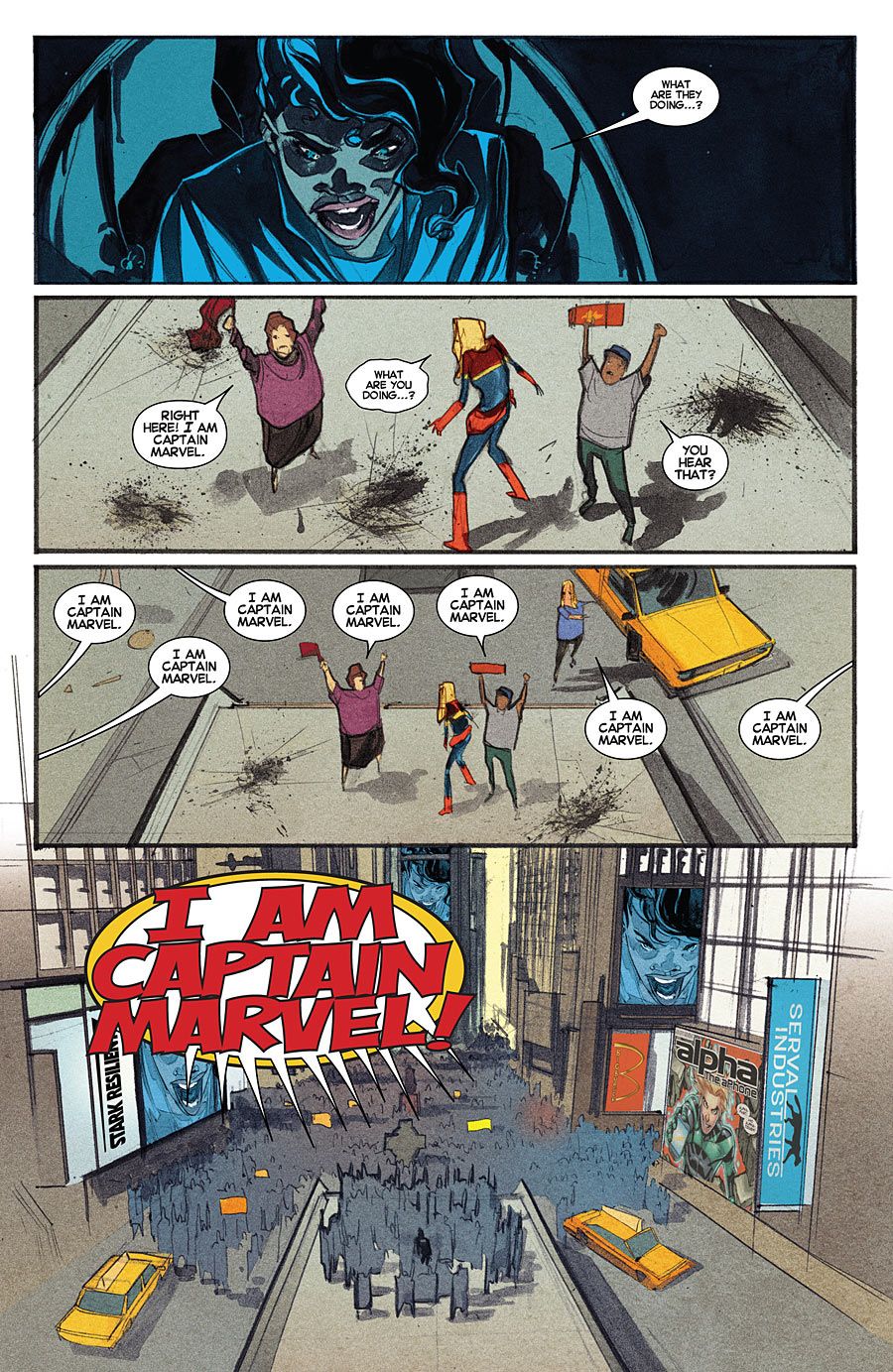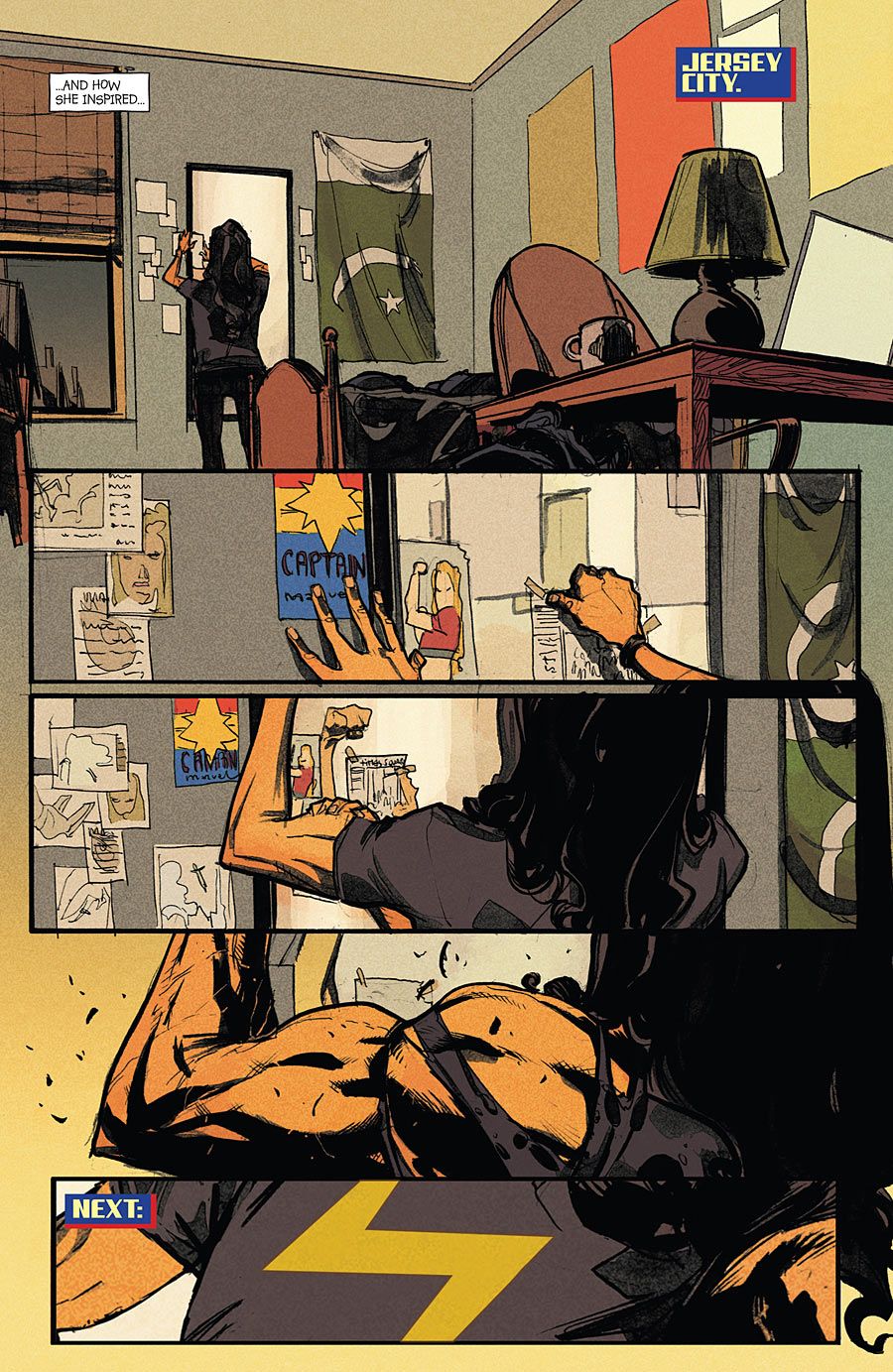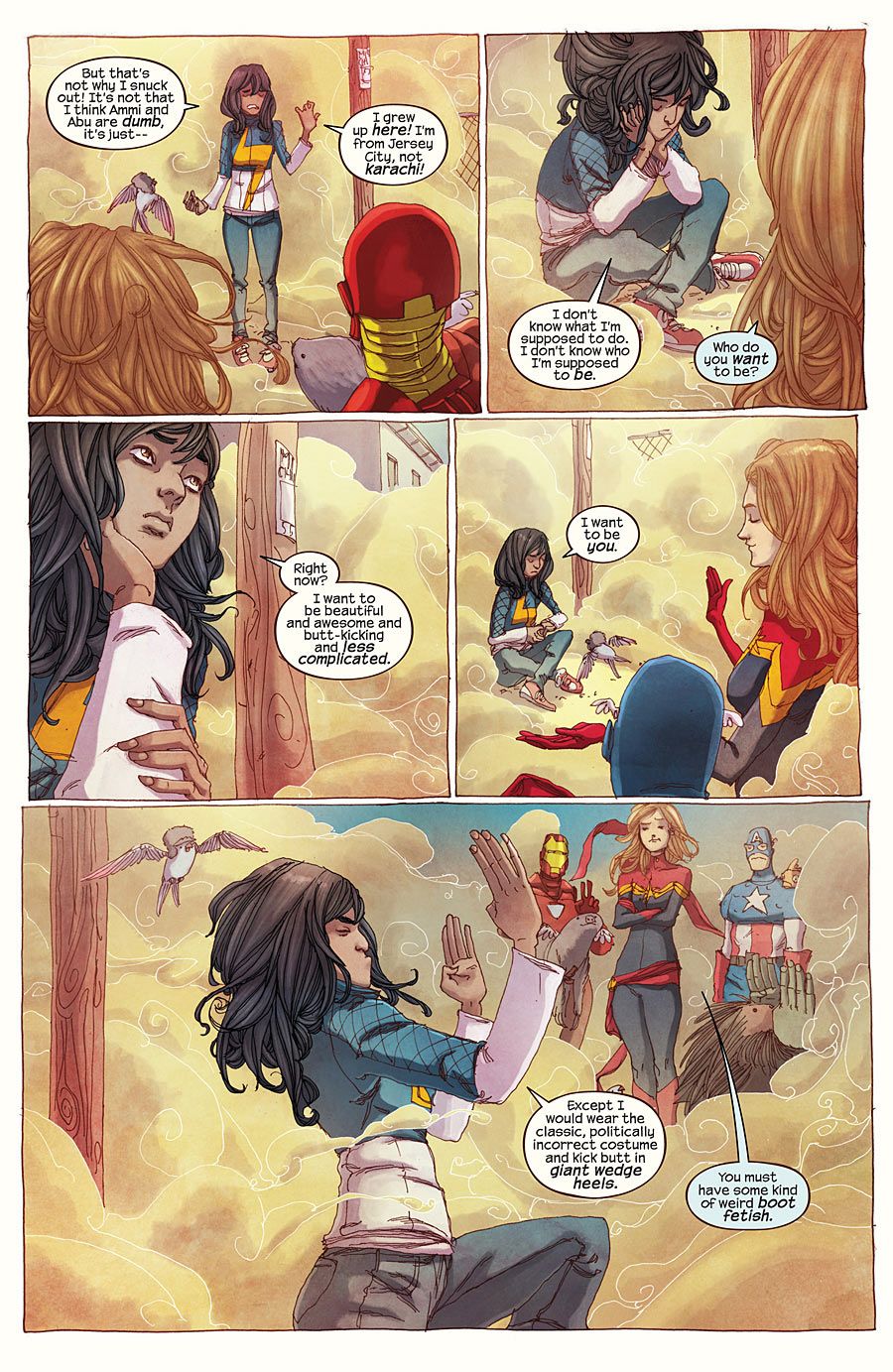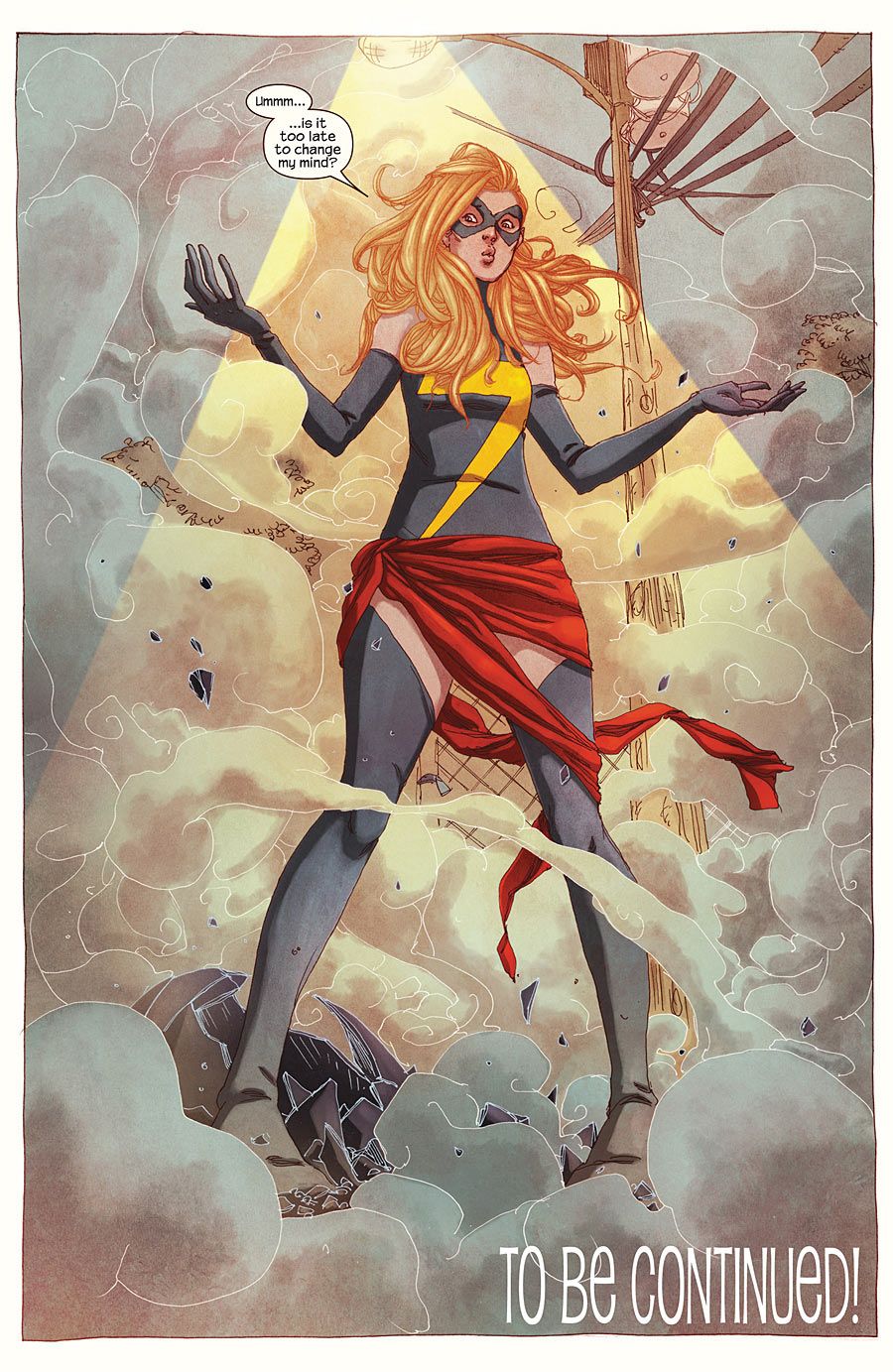With Marvel Studios reportedly closing in on an actress to portray Captain Marvel in future Marvel films and Carol Danvers playing a critical role in the currently unfolding "Civil War II" event, now's a great time to revisit -- or discover for the first time -- who, exactly, Captain Marvel is and what her legacy at Marvel Comics looks like.
The history of Captain Marvel began with 1967's "Marvel Super-Heroes" #12 (by Stan Lee, Gene Colan and Frank Giacoia), with one of the strangest set-ups for a Marvel superhero yet. Captain Mar-Vell was sent by the Kree military to Earth to investigate the planet and determine whether the Kree needed to dedicate themselves to destroy the planet (after the Earth heroes, the Fantastic Four, had drawn attention to the planet by defeating a few other Kree emissaries). Mar-Vell's commanding officer, Colonel Yon-Rogg (who was in love with Mar-Vell's girlfriend), wanted Mar-Vell dead, so he tried to sabotage Mar-Vell's mission.
In the next issue (with Roy Thomas now writing the series), Yon-Rogg tried to kill Mar-Vell but instead accidentally killed a human scientist, Walter Lawson, who was on his way to a restricted military base. Mar-Vell took on Lawson's identity and when he showed up at the base he met its head of security, a young woman named Carol Danvers, who was immediately suspicious of him. Yon-Rogg then tried to activate an old Kree sentry robot and have it kill everyone there, including Mar-Vell. Mar-Vell switches to his Kree battle uniform and saved their all of their lives. In all the confusion, they believed him to be a superhero called "Captain Marvel." That was the book's status quo for the first year of its existence -- Mar-Vell was spying on Earth, but while there he also ended up protecting the planet, while Carol Danvers investigated Lawson and Yon-Rogg kept trying to sabotage Mar-Vell's mission.
Eventually, Roy Thomas and Gil Kane decided to revamp the character. The initial set-up was supplied in "Captain Marvel" #16 (by Archie Goodwin, Don Heck and Syd Shores), where Mar-Vell helped stop a plot by Yon-Rogg and some other Kree higher-ups to overthrow the Kree's Supreme Intelligence. Yon-Rogg escaped to Earth and Mar-Vell convinced the Supreme Intelligence to let him take Yon-Rogg down (the Supreme Intelligence's first plan was just to blow up the Earth to get to Yon-Rogg). The Supreme Intelligence agreed, but gave Mar-Vell a new costume, special nega bands and a lock at the rank of "Captain." On the way to Earth, though, Mar-Vell got stuck in the Negative Zone. In the next issue (by Roy Thomas, Gil Kane and Dan Adkins), a new status quo debuted when Rick Jones discovered his own nega bands, and Jones can then switch places with Mar-Vell in the Negative Zone by clanging his nega bands together. This was, in effect, Roy Thomas' sly way of tying in the concept of the original Fawcett Comics Captain Marvel (where a young boy named Billy Batson shouts the name "Shazam!" to transform into Captain Marvel), as just like Billy Batson, Rick Jones disappears when Captain Marvel is drawn out of the Negative Zone. Mar-Vell now has the chance to track down Yon-Rogg to have their final confrontation, which takes place in "Captain Marvel" #18 (by Roy Thomas, Gil Kane, John Buscema and Dan Adkins) which also turns out to be a major moment in Carol Danvers' history.
Yon-Rogg uncovered a powerful piece of Kree machinery known as the Psyche-Magnitron and sought to use it to take control of the Kree Empire. Carol Danvers' investigation in the area ended when she was taken prisoner by Yon-Rogg. Mar-Vell then arrived to battle Yon-Rogg (and the powerful Mandroid, created by the Psyche-Magnitron). Eventually, Yon-Rogg tried to use his blaster on Mar-Vell, but accidentally shot Carol Danvers in her shoulder instead. This spurred Mar-Vell on to defeat Yon-Rogg. The only problem is that the Magnitron has now become unstable. Mar-Vell grabbed Carol and shielded her with his body as they escaped the explosion of the Magnitron, an explosion that seemingly killed Yon-Rogg. With Carol now saved, Captain Marvel went on to new adventures and was no longer involved with the military base. Eventually, writer/artist Jim Starlin took over the title and made Mar-Vell the Protector of the Universe, taking on Thanos a number of times. Carol, for her part, disappeared from the book except for a brief two-part appearance in "Captain Marvel" #34-35 (#34 was Starlin's final issue on the series -- though he would continue his cosmic stories in the pages of Warlock).
In 1976's "Ms. Marvel" #1 (by Gerry Conway, John Buscema and Joe Sinnott), readers witnessed the debut of a new hero. We also learned Carol Danvers left the security game and went back to her roots as a writer, working for J. Jonah Jameson's magazine, "Woman." The book's second issue revealed the secret origin of Ms Marvel. As it turns out, the Magnitron's explosion gave off high doses of radiation. Mar-Vell tried to shield Carol from the radiation, but instead the radiation passed through Mar-Vell and sort of merged Carol's DNA with Mar-Vell's Kree DNA, giving Carol roughly the same abilities as the man who tried to save her. "X-Men" writer Chris Claremont soon took over the writing duties on Carol's ongoing title, and used it to introduce some characters who would later become X-Men mainstays like Deathbird and Mystique. Meanwhile, Claremont's original "X-Men" collaborator, Dave Cockrum, also joined the book and re-designed Carol's costume. "Ms. Marvel" #23 marked the end of the series, though Carol had joined up with the Avengers late in the run and became a full-time member of "Avengers" after her series concluded. However, this time would be short-lived, as she was written out of the book in the infamous "Avengers" #200 (by David Michelinie, Jim Shooter, Mark Gruenwald, Bob Layton, George Perez and Dan Green).
In the issues leading up to "Avengers" #200, Carol mysteriously became pregnant. In #200, she gave birth and her baby quickly aged to adulthood. You see, her "baby" is actually Marcus, the son of Immortus, who fell in love with Carol from his home in Limbo. He used his machines there to make her fall in love with him and brought her to Limbo. He couldn't leave Limbo on his own, though, so instead he sort of implanted himself within Carol so he could be "born" on Earth to make it possible for them to be together. However, Hawkeye accidentally destroyed one of Marcus' machines that made it possible for Marcus to stay on Earth (the same machine caused time to run amok on the planet), forcing him to return to Limbo. Carol decided to go with him, since she was in love with him (due to his machines, you know, making her love him). The Avengers were okay with this for some reason, and Carol left with Marcus. Claremont was given the chance to address the story in "Avengers Annual" #10 (by Chris Claremont, Michael Golden and Armando Gil), where he revealed that the whole thing went to hell in a hand basket very quickly and Marcus died soon after and Carol returned to Earth. As soon as she arrived, however, she lost her powers to a new mutant known as Rogue. Saved by Spider-Woman, Carol went to go live at the X-Mansion with the X-Men. The Avengers visited her there and she berated them for letting her leave with Marcus.
Sadly, Carol lost not only her powers to Rogue, but her much of her memories and personality! While staying with the X-Men, dealing with her loss, Carol was abducted along with the X-Men by the evil Brood. The Brood subjected Carol to experiments that eventually unlocked a new energy-based power. She then became the cosmic hero known as Binary in "Uncanny X-Men" #164 (by Chris Claremont, Dave Cockrum and Bob Wiacek). She decided to remain in space as a member of the Starjammers. This effectively put Carol into comic book limbo for well over a decade. In the early 1990s, she eventually returned to Earth. When the Avengers reformed after the team broke up following the "Onslaught" crossover (where most of the main members of the Avengers were thought to be killed -- they actually ended up on an alternate Earth created by Franklin Richards), Carol rejoined the team. Now calling herself Warbird, she had developed a drinking problem while trying to come to terms with her lost emotions, leading to the Avengers putting her in front of a disciplinary committee in "Avengers" #7 (by Kurt Busiek, George Perez and Al Vey). She eventually dealt with her problem and returned to the team and served the team well.
When the Avengers reformed again after breaking up following the events of "Avengers Disassembled," Carol was one of the first heroes to join the new team (and began going by Ms. Marvel again around this time). During "Civil War," she sided with Iron Man and the pro-Superhero Registration forces. She even led Iron Man's government-approved Mighty Avengers. However, that soon fell apart when Norman Osborn took control of SHIELD (re-naming it HAMMER), a move that sent all good superheroes on the run and Carol joined up with her fellow Avengers who were already on the run from Iron Man. During this time, the villain Moonstone began going by the name Ms. Marvel, as well, as part of Norman Osborn's mockery of the Avengers, the Dark Avengers (where Bullseye was the team's Hawkeye, Venom was the team's Spider-Man, Daken was the team's Wolverine and Osborn himself was the team's Iron Man/Captain America as Iron Patriot). Eventually, Carol reclaimed her identity from Moonstone.
However, she did so soon before she decided to take on a brand-new identity. You see, after Mar-Vell sadly died of cancer years ago, a number of other heroes had taken on the mantle of "Captain Marvel," beginning with longtime Avenger Monica Rambeau, who was given the name by the media after she first got her powers. Monica ceded the name to Genis-Vell, the son of Mar-Vell, when he became a superhero himself. Genis-Vell gave up the name to his sister, Phyla-Vell. Eventually all of them gave up using the name. So it fell to Carol, who went by the name Captain Marvel during the altered reality of the House of M (where the Scarlet Witch altered reality to make mutants the ruling class of the world). Eventually, Carol's friends and teammates argued that she really should take over the name. So in 2012's "Captain Marvel" #1 (by Kelly Sue DeConnick and Dexter Soy), she did just that. Carol as Captain Marvel soon became a source of inspiration for the people of New York, as she had her own "Carol Corps" of fans. In a notable sequence in "Captain Marvel" #17 (by Kelly Sue DeConnick and Filipe Andrade), a villain sent a drone to attack Captain Marvel on a Captain Marvel Appreciation Day in New York City. Her fans then stepped in to save the day by each claiming that they were Captain Marvel, which confused the drone long enough for Carol to get rid of it. At the end of the issue (which was also the end of that particular volume), we see a mysterious teenager in Jersey City who was also inspired by Carol (the same girl briefly appeared in an earlier issue of "Captain Marvel").
In "Ms. Marvel" #1 (by G. Willow Wilson and Adrian Alphona), readers discovered that girl was Kamala Khan, a superhero-obsessed teen who was exposed to the Terrigen Mists and found herself given superpowers. While in the cocoon that new Inhumans find themselves in when exposed to the Mists, Kamala hallucinated meeting her idol, Captain Marvel. When she burst from the cocoon, she discovered she has the ability to shapeshift and took on Carol's old Ms. Marvel costume! Kamala soon decides to become a superhero, using the name Ms. Marvel and a modified version of Carol's old costume that also reflects Kamala's Muslim heritage.
So, in a lot of ways, we've come full circle -- Mar-Vell as Captain Marvel inspired the career of Ms. Marvel, and Carol Danvers, now Captain Marvel herself, has inspired the career of Ms. Marvel, Kamala Khan.
Hopefully Brie Larson is up to the challenge of the rich history of Carol Danvers -- Captain Marvel!

